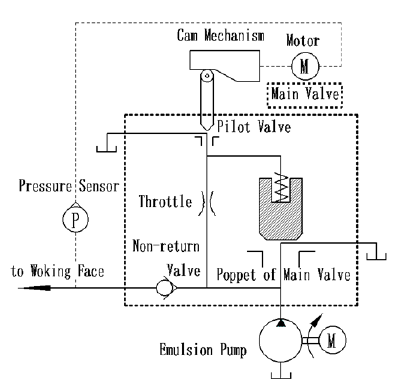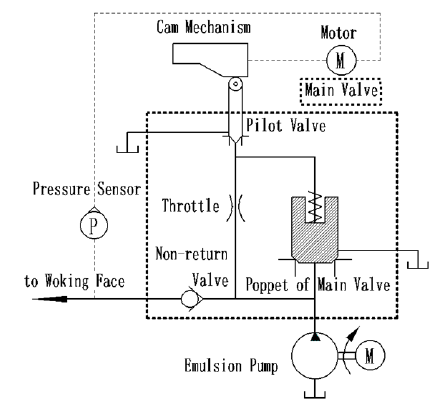- Submissions

Full Text
Aspects in Mining & Mineral Science
Motor Control Unloading Valve for High Pressure Hydraulic System of Coal Mining
Zhang Xi*, Meng Junzhou, Cao xiao, Guo Kui, Wei Yingle and Huang Lisha
China University of Mining & Technology, Beijing, Beijing 100083, China
*Corresponding author: Zhang Xi, China University of Mining & Technology, China
Submission: January 11, 2023;Published: January 19, 2023

ISSN 2578-0255Volume10 Issue4
Abstract
In this paper, a new type of motor-controlled unloading valve for high-pressure and large-flow hydraulic system of coal mining is reported. Here the motor-controlled unloading valve can control the pressure and flow of the emulsion pump, so as to the unloading and pressure building of the mining hydraulic system, by using the cam mechanism to control the pilot valve to open or close. The motor control unloading valve can be automatic with a very simple structure. And the advantages of the traditional mechanical unloading valve and electromagnetic unloading valve are well combined with the motor controlled unloading valve, and many disadvantages of the traditional mechanical unloading valve and electromagnetic unloading valve are avoided. Motor controlled unloading valves have good potential for development
Keywords:unloading valve; motor control; automatic control; emulsion pump; coal mining
Introduction
At present, there are two kinds of unloading valves on the market, which are unloading valve with mechanical pilot and unloading valve with electromagnetic pilot, the most used the most used pressure control method for controlling high pressure and large flow emulsion pump. Traditional mechanical unloading is cheap and be adjusted conveniently with simple structure. However, it needs to be manually adjusted unloading pressure, and it is difficult to start without load and be controlled automatically [1]. Unloading valve with electromagnetic pilot can be started and stopped without load through automatic control technology. So electromagnetic unloading valves, especially intrinsically safe electromagnetic unloading valves for coal mining, are now widely used. But intrinsically safe electromagnetic unloading valve is very prone to failure with the very precise and complex structure of pilot valve. As the technology of coal mining developing, the technical difficulties of high-pressure and large-flow emulsion pump have been overcome [2], the maximum pressure of underground hydraulic system has been raised to 50MPa [3], and the nominal flow rate has been raised more than 1000L/min [4]. Traditional emulsion pump stations and control technology can no longer meet the production requirements [5]. In order to acclimatize the development of mining technology to automation and intelligence, a motor control unloading valve is designed and manufactured, used for unloading high pressure and large flow emulsion pump station in coal mining.
Main Design Idea
As the Figure 1 shown, before the emulsion pump starts, the rod of the motor is on the right and the pilot valve spool is on the upper plane because of the emulsion pressure, so that the emulsion in the upper chamber of main valve can flow to the tank through the pilot valve. The hydraulic force on the chamber above the main valve spool is mainly exerted by the atmospheric pressure. Relative to the pressure of the emulsion pump for coal mining, the atmospheric pressure is very small which can be regarded as almost zero. As Figure 2 shows, when the pump starts working, the lower chamber of the main valve fills the high-pressure emulsion from the emulsion pump, so there is a great pressure difference between the upper chamber and the lower chamber of the main valve. The emulsion in the lower chamber of the main valve will push the main spool to move up under the pressure difference, and then enter the oil tank through the main valve. In this way, the emulsion pump can be launched with “zero pressure “. After the pump works steadily, the rod of motor will be pushed to the left to drive the cam mechanism. In this way, the pilot valve will move down to the lower plane under the action of the cam mechanism, in which case the passage between the chamber above the main valve and the oil tank is cut off. Then the high pressure emulsion begins to enter the chamber above the main valve through the throttle. After the chamber above the main valve is full of high pressure emulsion, the pressure value is equal between the upper chamber and the lower chamber of the main valve. At the same time, the main valve is closed with the main valve spool clamping down because of spring pressure. In this way, the high-pressure large flow emulsion will be transported to the working face by the emulsion pump later, as the non-return valve is opened.
Figure 1:Diagram of working state of launching the emulsion pump or loading.

Figure 2:Diagram of working state of offering emulsion pressure to working face.

When the pressure on the working face rises to a predetermined pressure, which is usually nominal pressure, the single chip microcomputer receives a signal from the pressure sensor and then controls the motor to rotate, so that the rod of the motor retracts to the right again. At the same time, the pilot valve spool moves upward, which means that the upper chamber of the main valve spool is connected to the oil tank. Then the emulsion in the upper chamber of the main valve flows back to the tank. Because of the throttle, the emulsion in the chamber above the main valve spool flows back to the tank faster than the emulsion in the chamber below the main valve spool. As a result, the emulsion pressure in the chamber below the main valve is higher than that in the chamber above. Under the pressure difference, the spool of the main valve moves upward, so that the pressure of hydraulic system is unloaded as the main valve is opened. After the pressure of the hydraulic system is unloaded to the lower predetermined pressure, the single chip microcomputer receives a signal again from the pressure sensor and then controls the motor to rotate again. In this stage, the actions of the pilot valve, main valve and the non-return valve are the same as themselves in the stage of the emulsion pump starting. The emulsion pump continues to provide high pressure and large flow emulsion to the working face until the pressure on the working face rises to the nominal pressure again.
Conclusion
An unloading valve witch’s motion is controlled by motor has been designed and manufactured. The advantages of traditional mechanical unloading valve, with simple structure, and electromagnetic unloading valve, controlled automatically, can be included in the motor control unloading valve measurably. The work about researching the optimization of motor control unloading valve, which has potential to replace traditional mechanical unloading valve and electromagnetic unloading valve, is going on.
References
- Wen QZ (2011) Research status and development trend of emulsion pump pressure control technologies. Coal Mine Machinery 32(06): 5-6.
- Li R (2019) Intelligent fluid supply technology in fully mechanized coal mining face and its development trend. Coal Science and Technology 47(09): 203-207.
- Zhang DS, Zhu K, Zhang S (2021) Coal engineering, current situation and development trend of rapid coal mining technology in fully mechanized mining face. Coal Engineering 53(11): 1-5.
- Ye J (2022) 1250L/min, 40MPa high pressure and large flow emulsion pump station. Journal of Intelligent Mine 3(01): 36-37.
- Hu P (2020) Research of flow and pressure automatic control technology of emulsion pumping station. Shanxi Coking Coal Science and Technology 44(10): 45-47.
© 2023 Zhang Xi. This is an open access article distributed under the terms of the Creative Commons Attribution License , which permits unrestricted use, distribution, and build upon your work non-commercially.
 a Creative Commons Attribution 4.0 International License. Based on a work at www.crimsonpublishers.com.
Best viewed in
a Creative Commons Attribution 4.0 International License. Based on a work at www.crimsonpublishers.com.
Best viewed in 







.jpg)






























 Editorial Board Registrations
Editorial Board Registrations Submit your Article
Submit your Article Refer a Friend
Refer a Friend Advertise With Us
Advertise With Us
.jpg)






.jpg)














.bmp)
.jpg)
.png)
.jpg)










.jpg)






.png)

.png)



.png)






